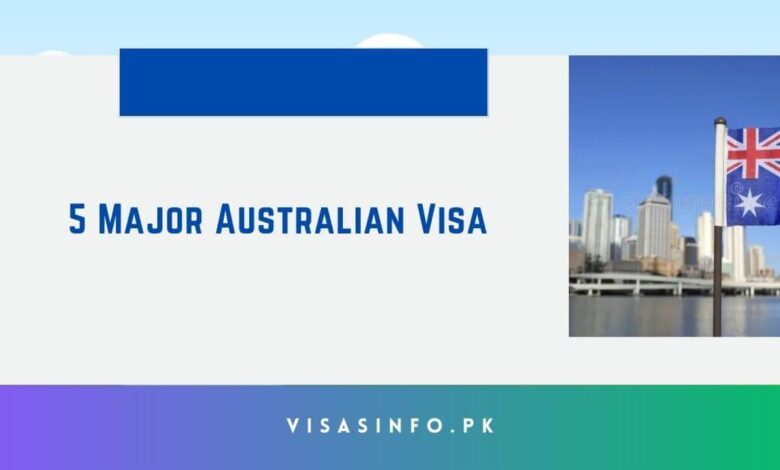5 Major Australian Visa Changes 2024 – Check Here

People who are interested in relocating to Australia are experiencing a variety of changes. The following are the five most significant updates regarding Australian immigration in 2024.
New South Wales 491 Visa Nomination Criteria
There are two application pathways available for the 491 Visa, and the sponsoring requirements have been made public by New South Wales.
Pathway 1: Directly applying to the New South Wales government
Pathway 2: involves the submission of an Expression of Interest for the initial year.
Candidates under pathway 1 are required to reside and work in a designated area of New South Wales and earn a minimum of $70,000 annually. Candidates may register from either onshore or offshore using Pathway 2, but they must satisfy specific residency requirements.
Focus on Immigration Reform
To mitigate abuses and expedite procedures, the Albanese government is ensuring that the immigration agency is proficiently managed. To maintain the proper functioning of the Visa system, over 680 personnel have been employed throughout Australia since May 2022. Provisional permanent status authorization is becoming increasingly challenging, despite the decreasing accumulation of temporary visa applications.
The Australian government is currently engaged in the process of addressing the housing shortage in the country, and there is a significant demand for employment in the construction industry. This is a positive development. As a result, it is expected that construction laborers will be among the most sought-after professions in the country shortly.
Australia Proposed Jail Term for Migrants
Australia is proposing a bill that would authorize penitentiary sentences for high-risk migrants. Immigrants who violate a specific condition of their visa may be sentenced to serve a maximum of five years in prison, as per a recently published parliamentary proposal. The 2004 ruling allowed for the indefinite detention of immigrants when it is not feasible to remove them from Australia. Prospect was overturned by the court, which subsequently determined that the indefinite detention of immigrants remains unlawful.
A bill that restricts the rights of specific immigrants and mandates the use of electronic surveillance bands was recently approved by the Australian government. It is prohibited to violate the provisions of a visa, as it could lead to legal consequences, according to Immigration Minister Andrew Giles.
Benefits of 5 Major Australian Visa
- Work Opportunities: A multitude of Australian visas permit employment within the nation, which can enable individuals to access a diverse array of employment opportunities and competitive salaries.
- Quality of Life: Australia is renowned for its exceptional standard of living, which encompasses superb healthcare, education, and social services.
- Permanent Residency Pathway: The Skilled Migration Visa and other visas offer a pathway to permanent residency and, ultimately, citizenship.
- Education Accessibility: Australia’s world-class educational institutions are accessible to students on student visas, and they may also be able to work part-time while they are studying.
- Healthcare Access: Certain visas provide access to Australia’s Medicare system, which offers subsidized healthcare services.
- Travel Flexibility: Numerous Australian visas permit travelers to enter and exit the country, which is advantageous for individuals who require international relocation for personal or professional reasons.
- Living in Australia: provides the opportunity to immerse oneself in the country’s distinctive lifestyle, stunning landscapes, and diversified culture.
- Support Services: Settlement assistance and community programs are frequently included in Australian visas.
Migration Amendment of 200 and 201 Visas
Australia has a long history of providing accommodation to individuals in need, and the government has implemented the Migration Amendment’s subclass 200 and 201 visa legislation. The Refugee and Humanitarian Visa program in Australia has been criticized for being overly restrictive and overly accessible. This is because a significant number of individuals who were attempting to escape persecution were unable to meet the rigorous requirements for these visas due to their vulnerability to exploitation and hopelessness.
The Australian government has implemented immediate measures to resolve these issues. The Migration Amendment Bill’s Subclass 200 and 201 Visas are designed to simplify the application procedure and facilitate the process of obtaining protection in Australia. Individuals who are fleeing persecution will be subject to the policy until 2024.
The Immigration Minister has been granted additional certification authority, which allows for the approval of applications for subclass 200 or subclass 201 refugee visas.
Check also: Top 3 Skilled Visa Options for PR in Australia
PR Pathway for TSS 482 Visa Holders
ENS funded by the employer 186 visas are available to all bearers of 482 temporary skill shortage visas. The applicant’s 482 TSS Visa was utilized for the occupation they specified. As opposed to three years of employment-supported 482 TSS sponsorship, holders of sponsored visas are eligible to petition for an 186 ENS TRT Visa after two years.
To qualify for the 186 TRT stream of the Employer Nomination Scheme Visa, applicants must satisfy all supplementary nomination and visa requirements. Currently, there is no restriction on the number of short-term stream 482 TSS Visa applications that are submitted onshore.
New Australia PR Pathway for 457 & 482 Visa Holders
November’s fourth report on the latest advancements in Australian immigration legislation. The primary modifications to immigration laws are the subject of this update. The migration regulations of 1994 have been significantly altered by the Australian government, and they will be implemented on November 25, 2023.
These developments should be of particular interest to holders of subclass 457 visas (temporary work qualified) and subclass 482 visas (temporary skill shortage).
The Permanent Residency Pathway for 457 and 482 Visa holders
This adjustment is exemplified by the establishment of a pathway within the temporary residence transition streams for all 457 Visa holders and the additional 482 main Visa holders. Given this, there has been a significant change in the policy regarding permanent residency, which now considers a more diverse perspective.
Health Waivers and Occupational Lists Adjustments
Another essential element of these modifications is the inclusion of a health waiver for specific Visa streams, which enhances accessibility for the majority of applicants. Furthermore, the OCC employment lists for subclasses 186 and 187 have been modified to simplify the application process.
What are the repercussions for applicants and visa holders?
The changes comprehensive impact should be recognized by both new applicants and those with valid visas. Qualified workers who are anxious to work in Australia are beginning to be more empathetically treated by the Australian government.
In general, the alterations to Australia’s immigration laws can be interpreted as a preliminary step toward more open and flexible immigration policies. Holders of subclass 457 and 482 visas are predominantly affected by the aforementioned modifications, which simplify the process of permanent residency and reduce the number of qualifying requirements. This represents a substantial change in the Australian immigration system.
Frequently Asked Questions:
-
What is a 5-year visa in Australia?
Upon receiving your first permanent visa, you typically enjoy a 5-year travel facility. As long as your permanent visa remains valid, you can leave and re-enter Australia as many times as you like within 5 years.
-
Which Australian visa is the best?
The skilled independent visa is a permanent resident visa. It is the most desirable visa because it provides the holder with the freedom and flexibility to live and work anywhere in Australia.
-
How many types of Australian visas are there?
Over 120 different types of Australian visas exist, each tailored to specific needs and with unique criteria. In this article, we will briefly discuss the common and major criteria for the most common Australian visa types.



